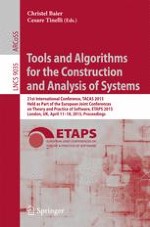This book constitutes the proceedings of the 21st International Conference on Tools and Algorithms for the Construction and Analysis of Systems, TACAS 2015, which took place in London, UK, in April 2015, as part of the European Joint Conferences on Theory and Practice of Software, ETAPS 2015. The 45 papers included in this volume, consisting of 27 research papers, 2 case-study papers, 7 regular tool papers and 9 tool demonstration papers, were carefully reviewed and selected from 164 submissions. In addition, the book contains one invited contribution. The papers have been organized in topical sections on hybrid systems; program analysis; verification and abstraction; tool demonstrations; stochastic models; SAT and SMT; partial order reduction, bisimulation, and fairness; competition on software verification; parameter synthesis; program synthesis; program and runtime verification; temporal logic and automata and model checking.
